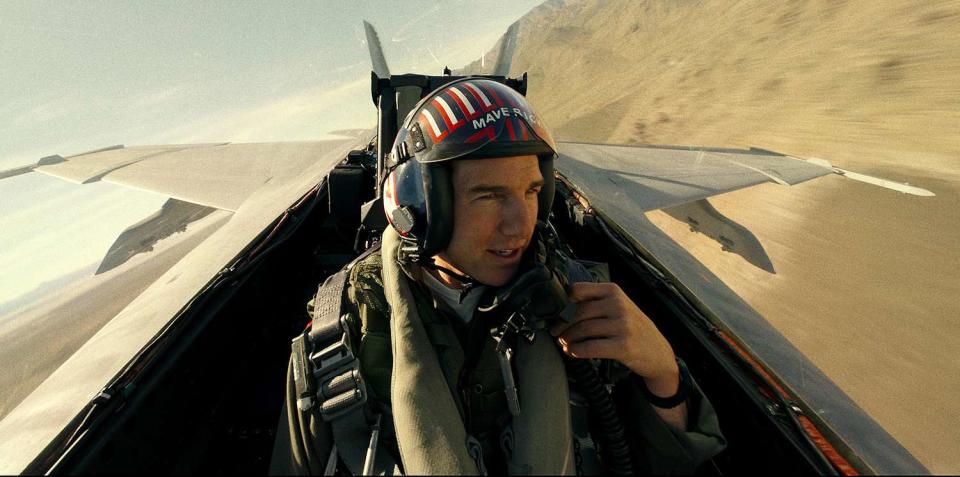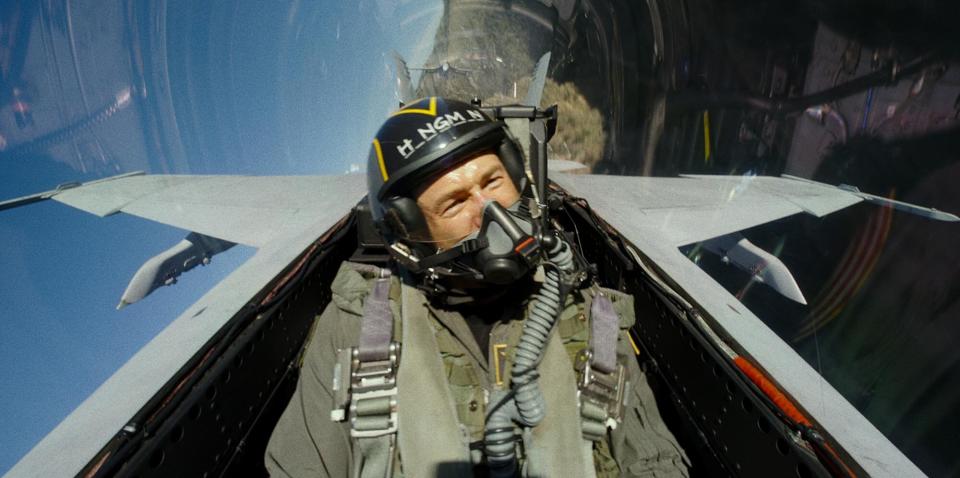The behind-the-scenes story of shooting those crazy Top Gun: Maverick flying sequences

- Oops!Something went wrong.Please try again later.
- Oops!Something went wrong.Please try again later.
How do you convincingly shoot scenes in which actors look like they are flying in jets with extreme G-forces contorting their facial features as the planes perform extreme aeronautical maneuvers? You get the actors to do it for real. That, at least, was the conclusion of Tom Cruise when he began to think about how to shoot Top Gun: Maverick (out May 27), the action sequel in which his titular flying ace must prep a younger generation of pilots for a highly dangerous mission.
"It's the craziest idea," says Glen Powell, who plays one of the pilots Maverick trains in the film. "You kind of don't believe it. It was like: Okay, this is a really cool idea but it's never going to work."
Yet work it did, with Cruise, Powell, and other cast members believably looking in the film like they are really in the skies because they really were in the skies.
"It was a lot of work," admits Top Gun: Maverick director Joseph Kosinski. "It was very tedious and difficult at times, but the footage speaks for itself."
When filmmaker Tony Scott directed the original 1986 Top Gun, he too had hopes of shooting actors in the air but was thwarted when cast members began throwing up whenever they were taken for a ride. "Though I was never really doing it, I learned the mechanics of operating the plane," Top Gun star Val Kilmer recalled in his 2020 memoir I'm Your Huckleberry. "We went up in the jets several times and... I have to report that I was the only one who didn't regurgitate, which, given the gut-wrenching drops and spins of those ferocious flights, was no mean feat."

Paramount Pictures Tom Cruise in 'Top Gun: Maverick'
In the years after Top Gun made him a global star, Cruise became a pilot himself thanks to Sydney Pollack, who directed him in 1993's The Firm and gave the actor flying lessons as a present. Cruise was determined to depict the aerial sequences in Top Gun: Maverick as realistically as possible, an ambition shared by Kosinski.
"I've always loved aviation, I was making model airplanes from a young kid and studied aerospace in school," says the director. "Every movie's a challenge, you know. I love that. If you don't have butterflies going into a project, it's probably not the right thing. I always want to look for something new to try and, yeah, this was a tough one but I had Jerry [Bruckheimer, the film's producer]. I had Tom, I had a great cast, and a story that we really believed in. So we gave it our best shot."
Cruise had played a military-school student in the 1981 film Taps and, together with costars Sean Penn and Timothy Hutton, attended a training boot camp ahead of the shoot. Inspired by that experience, the actor decided to put his fellow cast members through a training regimen which would allow them to be filmed in flying jets looking like actual, non-vomiting pilots.
"That was Tom's expertise," says Kosinski about Cruise's insistence that the actors be properly prepared for the shoot. "He's a pilot, and he's done aerobatics, and he was in the first Top Gun. He knew that they wouldn't be able to get in the plane and hold their lunch down and be able to do these scenes, so he created a training program that they all went through."
The actors began the schedule flying in single-engine Cessna 172 Skyhawks before moving on to the Extra 300, which is capable of more acrobatic maneuvers, finally graduating to L-39 Albatross single-engine high performance jets, which prepped them for the F/A-18s in which they would be filmed during the shoot.
"Tom used part of the budget of this movie in order to ensure that we were comfortable and able to emulate a real-life fighter pilot," says Powell. "There's no way without that regimen — a thing that he didn't have on the first movie — that we would be able to pull off these performances. There's full scenes up in the air and we would have been passed-out bodies just going for a ride."

PARAMOUNT PICTURES Glen Powell takes to the skies in 'Top Gun: Maverick'
Did Powell throw up over his plane? "Not on the plane," says the actor. "You've got bags obviously. I never missed a shot in the bag."
While the pilots were preparing to act like real pilots, Kosinski was figuring out how to shoot them doing so. "[That] took a lot of preparation," says the director. "We had to work for about 15 months with the navy to figure out how to get cameras in the cockpit. We ended up getting IMAX-quality cameras into the cockpit with the pilots and the actor."
During the shoot itself, Kosinski had the strange experience of "directing" actors who were many miles away during the actual filming.
"I'm there, with the actor, when they're getting in the jet, I'm setting the cameras up, making sure all the angles are exactly what we need," says the filmmaker. "But once that jet pulls out onto the runway, they're gone for the next hour or two. As soon as they land, we take the footage, we went into the debrief, we put it all in and watched it together. We give them notes on what didn't work, and we'd cheer when something was great, and then we'd give them notes and send them up again in the afternoon. It was a very unique way to direct, because it was a lot of prep and a lot of rehearsal. And it was very tedious — you're only getting a minute or two of good stuff every day. But it's the only way to get footage that looks like this."
The flight sequences in the finished film are certainly thrilling (EW's Leah Greenblatt praised Kosinski for "sending his jets swooping and spinning in impossible, equilibrium-rattling arcs"), aided by the fact that the cast's faces can be seen enjoying and enduring the aerial acrobatics.
"You just feel the peril for everyone in the movie in a different way," says Powell. "If you were using CGI, audiences are very smart, they can tell the difference. When you are whipping through canyons at 650 knots, you can't fake that, and you can't fake the Gs on actors faces."
So, if Top Gun: Maverick is a success, can Kosinski imagine overseeing more of such sequences in a sequel?
"It's all about the story for Tom," says the filmmaker. "If we can figure out a way to tell what Maverick's up to next, who knows?"
Want more movie news? Sign up for Entertainment Weekly's free newsletter to get the latest trailers, celebrity interviews, film reviews, and more
Related content:

